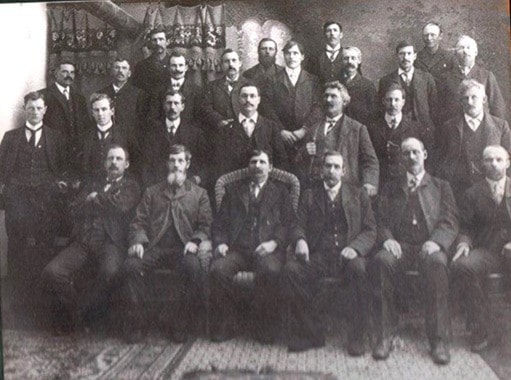There is no doubt that our great community has come a long way from that exciting historical milestone on July 27, 1891, when the first Canadian Pacific Railway train chugged into Siding 14 near what would soon become the Village of Ponoka. The vast and unbroken area grew at a rapid pace going into the 20th century, with hardy pioneer families seeking a new environment, some as farmers and ranchers looking to tame the rich land, others as tradesman, along with businessmen, professionals, and labourers ready to serve the expected urban and rural population explosion. From this overwhelming challenge, many men and women would emerge over the decades to our present day as leaders who must be ready, willing and able to compromise, work together and take this vibrant community into a bright future that has survived and thrived through many generations over the past 125 years. The weekly Reflections and Remember features will continue to salute the amazing efforts, contributions, and tenacity of our early pioneers.
Cook Myer and family.
Cook Myer was born on April 21, 1856 in Fountain County, Indiana as a member of a family of six boys and six girls who had immigrated to the United States from Europe. As the clan began to scatter and seek their own fame and fortune, Cook would move to Illinois at the age of 18, where he worked and made his home, then met and married Miss Almeda Pitts in 1872. To this union were born two sons, Henry and Thomas, and two girls, who died in infancy, and after getting tired of living on dirt floors and trying to scratch out a living, the family decided to make the long and gruelling three month trip in a covered wagon from Nebraska to the rich plains of Alberta.
Upon arrival they passed through the Village of Ponoka, spent their first winter on the shores of Gull Lake, then returned to Ponoka in the spring and homesteaded on a big hill east of town, which they later sold to the provincial government for the site of the new mental hospital. Among the many precious memories of Cook and Almeda’s grand-daughter Lillian Myer Babb was visiting their palatial big grey home at the north end of town (5020-53 Avenue), where they listened to granddad’s great stories of the old days, and sampled some of grandma’s scrumptious cooking.
In 1899, the Federal Department of the Interior had appointed Cook Myer as the official Land Guide for the Ponoka Area, with the government offering Freehold Title to pioneer families for $10, providing they stayed on the land for three years, during which time the they would break the land and build a home, and also keep up with their annual taxes of 6 cents an acre.. Advertisements that were distributed throughout Alberta and beyond stated that the land between Edmonton and Calgary offered the greatest advantages to settlers desirous of coming to the prairies, and guaranteed good soil, good water, coal, and wood in abundance. Through the great efforts and dedication of Cook Myer over the years, more than 300 new settlers found homes in the districts surrounding Ponoka. In the early days he and his wife Almeda also operated a ‘stopping house’ in the area that is now 50 Avenue and 50 Street, which accommodated many of the new arrivals into the districts, as well as operating a small stable in the back for ponies. Myer was a very friendly and popular gentleman; wherever he went, he loved to stop and visit, always took a keen interest in all public enterprises, helped to organize the first school service in Ponoka, then later became the first overseer of the village as well as being elected as the mayor in 1901.
Almeda Myer was a very busy little ‘homebody’ and a steadfast Christian, and in those days of no radio or television, the church filled the needs of her social life as well as to get through many hardships and sorrows, and was always willing to help so many others in the same regard. The Cook Myer family were highly loved and respected in those early beginnings of Ponoka, and also had a number of friends among the Cree Indians at Hobbema, who would always come for visits and bring the kindly family all sorts of berries and fish when they were in season. Cook, who never owned a car, always kept a team and buggy in his barn, and loved to put the top down and take the family and friends out for a drive throughout the community. He also kept rabbits, pigeons, and a cow at the big house in town, and Almeda would turn the lovely yellow cream into butter.
Her granddaughter Lillian vividly recalled in our Ponoka Panorama History Book that in her grandmother’s house, there was a room where the blinds were always down and the door shut. It had lovely rugs, stiff lace curtains, wax flowers, old photos, lovely little tables and hard chairs, and a bit of curl of hair in a frame. It was Almeda’s way of reaching out to others by hosting countless community weddings and funerals all year round. After making their home in Ponoka for several decades, Mr. and Mrs. Cook Myer moved to Florida for a short time, but their strong love and dedication for the community brought them back home here to farm the Ed Winter’s place, where they would live happily together to the ripe old ages of 82 and 84.
